The 5G RAN Market is estimated to be valued at USD 5.8 billion in 2025 and is projected to reach USD 71.8 billion by 2035, registering a compound annual growth rate (CAGR) of 28.7% over the forecast period.
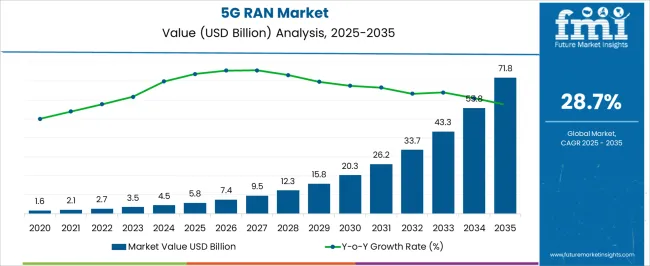
| Metric | Value |
|---|---|
| 5G RAN Market Estimated Value in (2025 E) | USD 5.8 billion |
| 5G RAN Market Forecast Value in (2035 F) | USD 71.8 billion |
| Forecast CAGR (2025 to 2035) | 28.7% |
The 5G RAN (Radio Access Network) market is advancing steadily, supported by the global transition to next-generation mobile connectivity, the proliferation of connected devices, and increasing demand for low-latency and high-throughput wireless infrastructure. Telecom operators are accelerating RAN deployments to meet enterprise, industrial, and consumer expectations for seamless data services.
Strategic investments in open RAN architecture, energy-efficient base stations, and virtualization technologies are reshaping cost structures and deployment models. Governments and private players are also prioritizing spectrum allocation and rural coverage expansion, which is creating favorable conditions for market penetration across developed and emerging regions.
Future growth will be influenced by scalable infrastructure models, AI-integrated network management, and the increasing convergence of cloud-native functions in distributed RAN environments.
The market is segmented by Component, Infrastructure Type, Spectrum Type, and Industry and region. By Component, the market is divided into Hardware, Software, and Services. In terms of Infrastructure Type, the market is classified into Macro Cell Infrastructure, Distributed Antenna System (DAS), Pure RAN Equipment, and Small Cell Infrastructure. Based on Spectrum Type, the market is segmented into Time Division Duplex (TDD), Frequency Division Duplex (FDD), and Others. By Industry, the market is divided into Telecom Operators and Other Enterprises. Regionally, the market is classified into North America, Latin America, Western Europe, Eastern Europe, Balkan & Baltic Countries, Russia & Belarus, Central Asia, East Asia, South Asia & Pacific, and the Middle East & Africa.
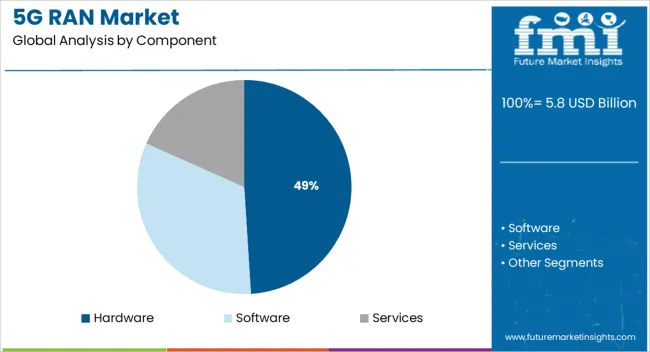
Hardware is projected to account for 49.0% of the total 5G RAN market revenue in 2025, establishing it as the dominant component segment. This leadership is being driven by widespread deployment of physical infrastructure, including baseband units, radios, and antennas essential for high-capacity and high-frequency 5G services.
The increasing rollout of standalone 5G networks and demand for Massive MIMO and beamforming capabilities have elevated the need for advanced hardware solutions. Hardware remains a fundamental cost driver in RAN expansion, especially for operators prioritizing high throughput and ultra-reliable connectivity.
Continued innovation in chipsets, energy-efficient transceivers, and hardware acceleration technologies is reinforcing this segment’s prominence in urban and suburban deployments.
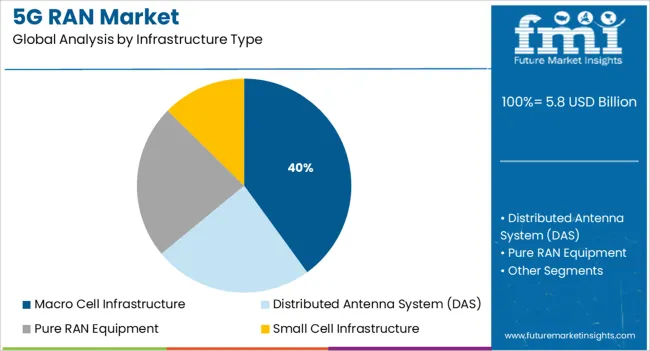
Macro cell infrastructure is expected to represent 40.0% of the market revenue in 2025, positioning it as the leading infrastructure type in 5G RAN deployments. This is being supported by the need for broad coverage, high-power transmission, and long-range signal propagation, especially in dense metropolitan areas and highways.
Macro cells serve as the backbone of national 5G rollouts, enabling efficient spectrum utilization across mid and high bands. Their ability to support a large number of concurrent users and applications makes them a cornerstone of public and enterprise network strategies.
As governments mandate comprehensive 5G coverage, especially for mission-critical and public service applications, macro cells are expected to remain pivotal in meeting service-level benchmarks.
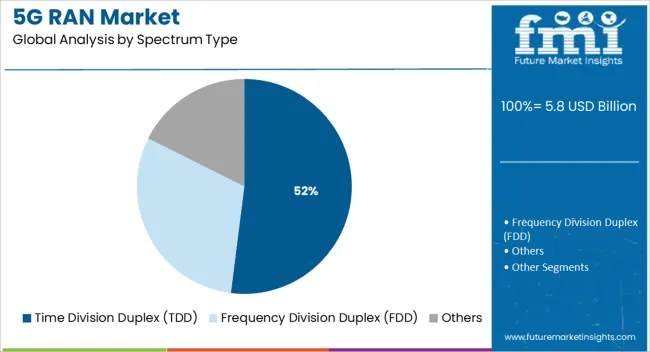
Time Division Duplex (TDD) is projected to hold a 52.0% revenue share in the 5G RAN market by 2025, ranking it as the most utilized spectrum configuration. This dominance is attributed to TDD’s flexibility in uplink and downlink traffic balancing, which aligns with dynamic usage patterns across mobile broadband and IoT networks.
The adoption of mid-band and high-band frequencies, particularly in regions emphasizing capacity over coverage, has favored TDD implementation. Additionally, TDD enables greater spectral efficiency and is well-suited for Massive MIMO deployments, which are central to delivering 5G’s promised speed and responsiveness.
Regulatory allocation of TDD-friendly bands across major economies has further solidified its role in nationwide 5G frameworks, especially where asymmetric data demand requires adaptable solutions.
The 5G RAN market is expected to witness robust growth in the Asia Pacific region during 2025 to 2035 on account of consumers' high demand and appetite for mobile broadband, initiating the region's participation in the digital economy.
Further, the regional growth can also be attributed to the relatively high presence of the young population in Asian countries compared to traditional markets like North America and Europe, leading to a greater willingness to adopt new technologies faster.
Further, the Asia Pacific is expected to witness robust activity to deploy 5G over satellite, providing impetus to regional growth. Additionally, the emergence of 5G is expected to boost the importance of satellites and result in new applications, such as the Internet of Things (IoT), network densification, and connected transportation.
5G technology, formally launched in India on 1st October 2025 by PM Narendra Modi, is in its first phase and is expected to reach only select customers. Cities such as Bengaluru, Delhi, Ahmedabad, Chandigarh, Chennai, Gandhinagar, Hyderabad, Gurugram, Jamnagar, Pune, Kolkata, Mumbai, and Lucknow, have been shortlisted for the first phase rollout. The next-gen network will become accessible to other, Tier-II and -III cities and villages.
Companies such as Nokia, Samsung, Bharti Airtel, and Ericsson have placed orders for 5G gears. The 5G RAN market is predicted to observe an upsurge in its uptake due to the ongoing infrastructural developments and vigorous attempts by the major broadband operators to enable accessibility to novel technology in the forecast period of 2025 to 2035.
Further, the 5G RAN market is predicted to witness healthy growth in the upcoming years due to the next-gen readiness key players like Samsung, which are strengthening their footprint in the major regions, such as North America and the Asia Pacific.
RANs have evolved significantly over the past years as cellular networking technology reaches 5G. Silicon chips in core network and cellular mobile devices complement the functionalities of RAN. Today, 5G RAN technology has the ability to support Massive Multiple Input Multiple Output (Massive MIMO) technology, multi-band carrier aggregation, vast spectrum bandwidths, and more.
Evolution of 5G RAN is estimated to have a great impact on the growth of wireless networking technologies, and is projected to accommodate network slicing and Mobile Edge Computing (MEC). 5G RAN technology is also likely to contribute to lowering latency which will make 5G technology even more powerful. Such advancements are expected to boost the demand for 5G RAN in a spiralling manner over the coming days.
Surge in use of smart devices
Wireless devices connect to cellular networks via Long Term Evolution (LTE) or 5G New Radio (NR) connectivity. Most transceivers or base stations are in connection via fibre backhaul to mobile core network. RANs provide radio communication access and assists coordinative network resources across all wireless devices.
Information & communication infrastructure
Infrastructure has always been the top priority of countries with regards to strategic investments. The telecom sector across the world is rapidly growing with governments making huge investments in IT infrastructure. This trend is estimated to propel the adoption of 5G RAN across every regional market.
Government assistance
Strategic investments in telecom sector help governments harness the potential to create employment and drive economic growth of countries. Ongoing advancements in 5G technology have great potential to transform telecommunication industry vertical and enhance usage experience for end-users.
Upgrading existing telecom infrastructure
Many enterprises operating in the telecommunication industry across the globe are focusing on upgrading their existing networking infrastructure to 5G networking infrastructure. This can help such telecom service providers offer services with high performance and high speed connectivity. Thus, huge investments targeted at upgrading national telecom infrastructure is the key factor estimated to boost the adoption of 5G RAN technology during the forecast period.
Proliferation in adoption of cloud services
RANs utilize radio wave transceivers to connect the device to the cloud infrastructure. With the growing adoption of cloud services across several end use sectors is anticipated to propel the adoption of 5G RAN services over the projected timeframe.
Deployment of 5G technology in key industry verticals, like Automotive, Transportation and Logistics, is estimated to boost the adoption of 5G RAN solutions and services. Government and public sector and healthcare industry verticals are also estimated to record a spike in adoption rates. However, the overall growth rate is estimated to carry on undeterred with consistent adoption of 5G RAN in the services sector.
5G RAN markets in North America and Europe are leading all other regional markets on a global level. 5G RAN markets in Latin America and Middle East and Africa region will be slower to gain traction during the forecast period, as LTE Advanced technology is still gaining diffusion in those regional markets.
The strong 5G RAN market share of 23.3% in North America may be attributed to high presence of 5G technology solutions and service providers in the region.
Due to the presence of significant technological firms throughout the area, North America is predicted to remain as a very promising market for 5G RAN market. Also, advancements in 5G technology for automotive and smart transportation are playing a key role in propelling 5G RAN market growth in North American economies.
During the projected period, the Asia Pacific region is expected to lead the 5G RAN market with its highest share of 30.4%.
5G RAN market in Southeast Asia Pacific region is projected to register a strong growth rate over the forecast period. This is due to the aggressive rollout of 5G infrastructure by a plethora of service providers in the region, having a big positive impact on market expansion. Moreover, initiatives and investments deployed by government organizations are also propelling the adoption of 5G technology, thus driving the 5G RAN market.
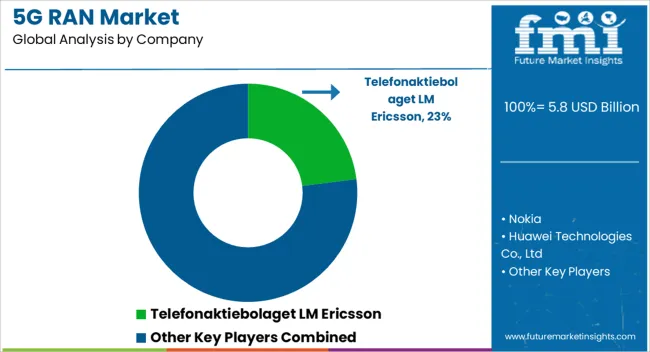
How is the Start-up Ecosystem in the 5G RAN Market?
At present in 5G RAN market, a few number of national, and international competitors have promptly extended the 5G technology and are actively competing making it somewhat consolidated. Further, in order to expand their service portfolios and capture a sizable portion of the market, industry participants have indeed been focused on inorganic expansion methods as well.
However, as per the 5G RAN market analysis by FMI, more and more number of telecom operators are very likely to get into the market soon making it highly fragmented. Moreover, new 5G RAN market participants or start-ups are consistently involved in R&D operations to create new items that would satisfy consumer needs and acquire them new client base.
Recent Developments in the Global 5G RAN Market
| Attributes | Details |
|---|---|
| Growth Rate | CAGR of 28.7% from 2025 to 2035. |
| Base year for Estimation | 2025 |
| Historical Data Available for | 2020 to 2024 |
| Forecast Period | 2025 to 2035 |
| Quantitative Units | Revenue in USD Million and CAGR from 2025 to 2035 |
| Report Coverage | Revenue Forecast, Volume Forecast, Company Ranking, Competitive Landscape, Growth Factors, Trends and Pricing Analysis. |
| Segments Covered | Component, Infrastructure, Spectrum, Industry, Regions |
| Regions Covered | North America; Latin America; Asia Pacific; Japan; Western Europe; Eastern Europe; Middle East & Africa |
| Key Countries Profiled | The USA, Canada, Brazil, Argentina, Germany, The UK, France, Spain, Italy, Nordics, BENELUX, Australia & New Zealand, China, India, GCC, South Africa |
| Key Companies Profiled | Nokia; Telefonaktiebolaget LM Ericsson; Huawei Technologies Co., Ltd.; Verizon; ZTE Corporation; NEC Corporation; Cisco; Qualcomm Technologies, Inc.; SAMSUNG; Intel; FUJITSU |
The global 5G RAN market is estimated to be valued at USD 5.8 billion in 2025.
The market size for the 5G RAN market is projected to reach USD 71.8 billion by 2035.
The 5G RAN market is expected to grow at a 28.7% CAGR between 2025 and 2035.
The key product types in 5G RAN market are hardware, software and services.
In terms of infrastructure type, macro cell infrastructure segment to command 40.0% share in the 5G RAN market in 2025.






Full Research Suite comprises of:
Market outlook & trends analysis
Interviews & case studies
Strategic recommendations
Vendor profiles & capabilities analysis
5-year forecasts
8 regions and 60+ country-level data splits
Market segment data splits
12 months of continuous data updates
DELIVERED AS:
PDF EXCEL ONLINE
5G Millimeter Wave RF Transceiver Market Size and Share Forecast Outlook 2025 to 2035
5G in Automotive and Smart Transportation Market by Solution ,Application,Industry , Warehousing & Logistics, Warehousing & Logistics, Public Safety and Others & Region Forecast till 2025 to 2035
5G Solid State Switches Market Size and Share Forecast Outlook 2025 to 2035
5G Gain Block Amplifier Market Size and Share Forecast Outlook 2025 to 2035
5G Driver Amplifier Market Size and Share Forecast Outlook 2025 to 2035
5G Testing Market Size and Share Forecast Outlook 2025 to 2035
5G in Healthcare Market Analysis Size and Share Forecast Outlook 2025 to 2035
5G Temperature-Compensated Crystal Oscillator (TCXO) Market Size and Share Forecast Outlook 2025 to 2035
5G Remote Surgery System Market Analysis - Size, Share, and Forecast Outlook 2025 to 2035
5G Telemedicine Platform Market Size and Share Forecast Outlook 2025 to 2035
5G Industrial IOT Market Size and Share Forecast Outlook 2025 to 2035
5G IoT Market Size and Share Forecast Outlook 2025 to 2035
5G in Defense Market Size and Share Forecast Outlook 2025 to 2035
5G Enterprise Private Network Market Size and Share Forecast Outlook 2025 to 2035
5G Edge Cloud Network and Services Market Size and Share Forecast Outlook 2025 to 2035
5G Automotive Grade Product Market Size and Share Forecast Outlook 2025 to 2035
5G Enterprise Market Size and Share Forecast Outlook 2025 to 2035
5G Infrastructure Market Size and Share Forecast Outlook 2025 to 2035
5G Security Market Size and Share Forecast Outlook 2025 to 2035
5G Testing Equipment Market Analysis - Size, Growth, and Forecast 2025 to 2035

Thank you!
You will receive an email from our Business Development Manager. Please be sure to check your SPAM/JUNK folder too.
Chat With
MaRIA